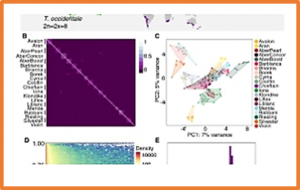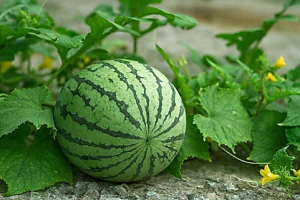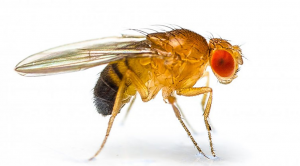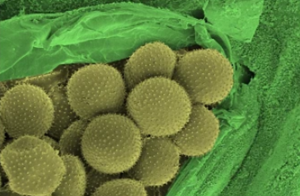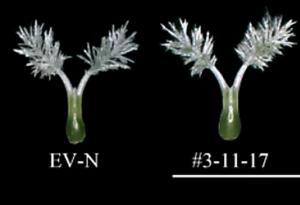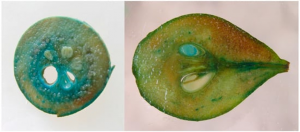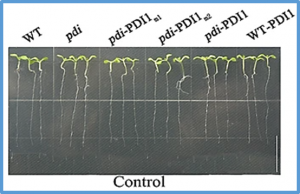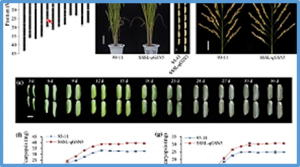Quantitative understanding of factors driving yield increases of major food crops is essential for effective prioritization of research and development. Yet previous estimates had limitations in distinguishing among contributing factors such as changing climate and new agronomic and genetic technologies. Here, we distinguished the separate contribution of these factors to yield advance using an extensive database collected from the largest irrigated maize-production domain in the world located in Nebraska (United States) during the 2005-to-2018 period.
Rice blast seriously threatens rice production worldwide. Utilizing the rice blast resistance gene to breed rice blast-resistant varieties is one of the best ways to control rice blast disease. Using a map-based cloning strategy, we cloned a novel rice blast resistance gene, Pi65, from the resistant variety GangYu129 (abbreviated GY129, Oryza sativa japonica). Overexpression of Pi65 in the susceptible variety LiaoXing1 (abbreviated LX1, Oryza sativa japonica) enhanced rice blast resistance, while knockout of Pi65 in GY129 resulted in susceptibility to rice blast disease.
Lateral branching is one of the most important traits, which directly determines plant architecture and crop productivity. Commercial watermelon has the characteristics of multiple lateral branches, and it is time-consuming and labor-costing to manually remove the lateral branches in traditional watermelon cultivation. In our present study, a lateral branchless trait was identified in watermelon material WCZ, and genetic analysis revealed that it was controlled by a single recessive gene, which named as Clbl (Citrullus lanatus branchless)
A recurring target-site mutation identified in various pests and disease vectors alters the voltage gated sodium channel (vgsc) gene (often referred to as knockdown resistance or kdr) to confer resistance to commonly used insecticides, pyrethroids and DDT. The ubiquity of kdr mutations poses a major global threat to the continued use of insecticides as a means for vector control. In this study, we generate common kdr mutations in isogenic laboratory Drosophila strains using CRISPR/Cas9 editing
Genomic analysis for heat and combined heat–drought resilience in bread wheat under field conditions
As heat (H) and drought stresses occur concurrently under field conditions, studying them separately offers limited opportunities for wheat improvement. Here, a wheat diversity panel containing Aegilops tauschii introgressions was evaluated under H and combined heat–drought (HD) stresses to identify quantitative trait loci (QTLs) associated with resilience to the stresses, and to assess the practicability of harnessing Ae. tauschii diversity for breeding for combined stress resilience. Using genome-wide analysis, we identified alleles and QTLs on chromosomes 3D, 5D, and 7A controlling grain yield (GY), kernel number per spike, and thousand-kernel weight, and on 3D (521–549 Mbp) controlling GY alone.
Stripe rust, or yellow rust (YR), is a major fungal disease of wheat (Triticum aestivum) caused by Puccinia striiformis Westend f. sp. tritici (Pst). Since 2011, the historically clonal European Pst races have been superseded by the rapid incursion of genetically diverse lineages, reducing the resistance of varieties previously showing durable resistance. Identification of sources of genetic resistance to such races is a high priority for wheat breeding. Here we use a wheat eight-founder multi-parent population genotyped with a 90,000 feature single nucleotide polymorphism array to genetically map YR resistance to such new Pst races.
The style length (SYL) in rice is one of the major factors influencing the stigma exertion, which affects the outcross rate of male sterile line and the yield of hybrid F1 seeds. However, the biological mechanisms underlying SYL elongation remain elusive. Here, we report a map-based cloning and characterisation of the allele qSYL3-k. The qSYL3-k allele encodes a MADS-box family transcription factor, and it is expressed in various rice organs.
Breeding woody plants is a very time-consuming process, and genetic engineering tools have been used to shorten the juvenile phase. In addition, transgenic trees for commercial cultivation can also be used in classical breeding, but the segregation of transgenes in the progeny of perennial plants, as well as the possible appearance of unintended changes, have been poorly investigated.
In the present study, encoding sequences of AtPDI1 of wild-type (WT) and double-cysteine-mutants were transformed into an AtPDI1 knockdown Arabidopsis line (pdi), and homozygous transgenic plants named pdi-AtPDI1, pdi-AtPDI1m1 and pdi-AtPDI1m2 were obtained. Compared with the WT and pdi-AtPDI1, the respective germination ratios of pdi-AtPDI1m1 and pdi-AtPDI1m2 were significantly lower under abiotic stresses and exogenous ABA treatment,
Grain size and grain number are two factors that directly determine rice grain yield; however, the underlying genetic mechanisms are complicated and remain largely unclear. In this study, a chromosome segment substitution line (CSSL), CSSL28, which showed increased grain size and decreased grain number per panicle, was identified in a set of CSSLs derived from a cross between 93-11 (recipient) and Nipponbare (donor). Four substitution segments were identified in CSSL28, and the substitution segment located on chromosome 5 was responsible for the phenotypes of CSSL28.


 Curently online :
Curently online :
 Total visitors :
Total visitors :

